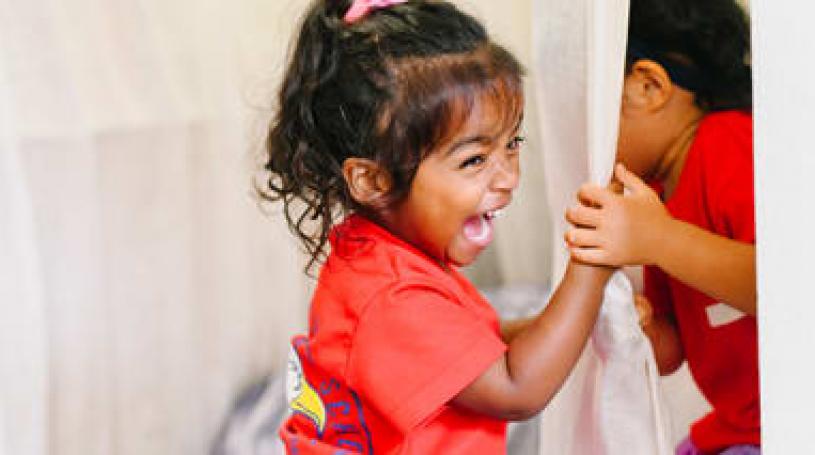Cultivating Healthy Habits in Your Kids
Early childhood is when kids begin to learn about themselves and the world in which they live in. It is also the time when they can start to develop healthy habits that will bring lifelong benefits. The key to cultivating good habits is to start early on and to stay consistent throughout.

Early childhood is when kids begin to learn about themselves and the world in which they live in. It is also the time when they can start to develop healthy habits that will bring lifelong benefits. The key to cultivating good habits is to start early on and to stay consistent throughout. Singapore American School’s early learning center teachers share top eight healthy habits you can adopt to get you and your family started:
- Stay active
It is important to keep your child active. Encourage your child to stretch, run, play with a ball, cycle around the block, and more. Engaging in physical play outside will allow your child to enjoy better sleep, better mental health, which will then improve their focus at school. Supporting a healthy and developing body is the goal!
- Cook together and eat healthy together
Getting your child involved in the meal planning, grocery shopping, and preparing of ingredients not only adds the perk of extra quality time but also helps model nutritious eating habits for your kids to follow.
If you’re dealing with a picky eater, introduce the idea of eating a rainbow by pointing out the selection of colorful options on their plate. Expose your child to a variety of raw vegetables, fruit, dips, and sauces. Most of these choices have anti-inflammatory and antioxidant effects that may benefit your child’s health.
- Limit screen time
According to the American Academy of Pediatrics, there is sufficient evidence that recommends no more than one hour per day on digital media for children between two and five years old. This will allow children ample time to engage in other activities important to their health and development.
You could challenge your entire family to skip screen time for a designated time period to encourage interaction while enjoying healthy activities as a family. Invest in inexpensive board games like Heads Talk, Tails Walk, Zingo—Bingo with a Zing, Colorama, and more!
- Wash up
Hand washing is definitely one of the most important habits to establish early on. Teach your child to wash their hands before and after they eat, after using a restroom, and after they come home from playing outdoors. Explain the importance of this habit and focus on the right techniques.
The US Centers for Disease Control and Prevention recommend the following steps for hand-washing:
- Wet your hands with running water and apply soap
- Rub your hands together to make a lather. Scrub well for at least 20 seconds
- Pay special attention to your wrists, the backs of your hands, between your fingers, and under your fingernails
- Rinse your hands well under running water
- Use a clean towel to dry your hands, or air-dry your hands
- Hydrate
Remind your child that they should drink enough water daily. Skip sodas, sweetened drinks, and serve water with meals and snacks. If your child needs a dash of flavor, add limes, lemons, or cucumbers to their glass of water.
- Mindfulness Exercises
The practice of mindfulness has been part of many schools’ timetables as it provides children with the tools they need to build confidence and cope with stress. The Collaborative for Academic, Social, and Emotional Learning (CASEL) has linked mindfulness to two core social-emotional skills—self-regulation and self-awareness. Skills in these areas teach students not only how to recognize their thoughts, emotions, and actions, but also how to react to them in positive ways. Here are some examples of mindfulness exercises you could try at home:
- Yoga: There are various tutorials online that can help teach them simple yoga poses.
- Breathing board: Have your child follow the line with their finger as they take calm, measured breaths.
- Stretching: Encourage your child to stretch different parts of their body starting from the head to their toes
- Rainbow walk: Go on a walk with your child and encourage them to find something red, orange, yellow, green, blue, indigo, and violet
- Sleeping Habits
According to the National Sleep Foundation, children aged three to five years old need about 11 to 13 hours of sleep every night. In some cases, preschoolers may still need their naps during the day. Choose to reduce your child’s activities leading up to their bedtime in order to keep them calm. Establish a consistent bedtime routine and include relaxing and enjoyable activities, such as a bath and bedtime stories.
- Reading
It is important to practice daily reading at home as a family. Set aside a “reading time” where the whole family sits down to read. You could also visit the local library or bookstore so they can pick out the books that they will enjoy. The more your child practices reading materials of their choice, the better readers they become!

